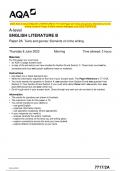Summary
Summary General Chemistry Effective Nuclear Charge and Trends, Electron Configuration and Nuclear Charge, Ionic Radii, Metals and Their Electron Loss, Ionization Energy and Electron Removal Spectra
- Course
- Institution
Are you struggling to grasp the fundamental concepts of General Chemistry? Our document study guide is designed to simplify complex topics and enhance your learning experience. Effective Nuclear Charge and Trends: Understand how effective nuclear charge influences atomic structure and periodic ...
[Show more]












